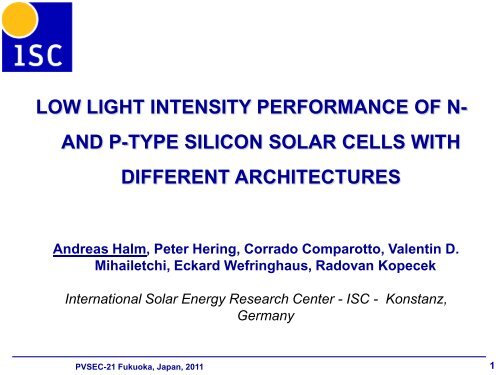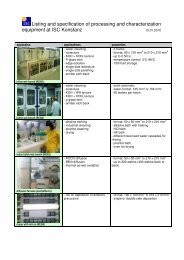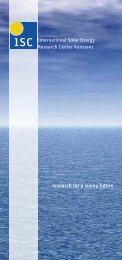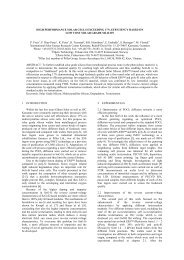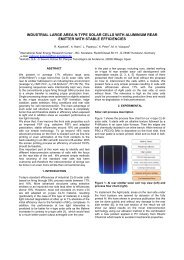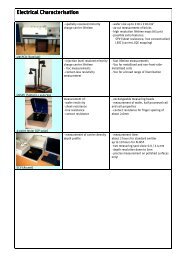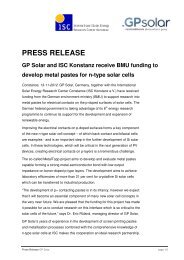Low Light Intensity Performance of N- and P-Type ... - ISC Konstanz
Low Light Intensity Performance of N- and P-Type ... - ISC Konstanz
Low Light Intensity Performance of N- and P-Type ... - ISC Konstanz
Create successful ePaper yourself
Turn your PDF publications into a flip-book with our unique Google optimized e-Paper software.
LOW LIGHT INTENSITY PERFORMANCE OF N-<br />
AND P-TYPE SILICON SOLAR CELLS WITH<br />
DIFFERENT ARCHITECTURES<br />
Andreas Halm, Peter Hering, Corrado Comparotto, Valentin D.<br />
Mihailetchi, Eckard Wefringhaus, Radovan Kopecek<br />
International Solar Energy Research Center - <strong>ISC</strong> - <strong>Konstanz</strong>,<br />
Germany<br />
Andreas Halm, PVSEC-21 Fukuoka, Japan, 2011 1
contents<br />
• motivation – potential advantage <strong>of</strong> n-type<br />
solar cells <strong>and</strong> modules<br />
• lV measurements <strong>of</strong> p- <strong>and</strong> n-type cells at<br />
low light intensities<br />
• influence <strong>of</strong> the shunt resistance<br />
• outdoor module measurements<br />
• summary<br />
Andreas Halm, PVSEC-21 Fukuoka, Japan, 2011 2
motivation<br />
N-type on wafer level: n-type base material maintains high lifetimes for<br />
low injection levels at the presence <strong>of</strong> common impurities like Fe<br />
• n-type FZ: D. Macdonald et al., APL Vol 85 Nr<br />
18, p. 4061-4063, 11.2004<br />
• n-type mc: S. Dubois PhD thesis<br />
more relevant on cell level: diffusion length LD<br />
Effective<br />
carrier density<br />
[1/cm³]<br />
LD p-type<br />
[µm]<br />
LD n-type<br />
[µm]<br />
1e15 312 304<br />
2e14 240 298<br />
S. Dubois, PhD thesis, 2006, INES, France<br />
-> potential advantage <strong>of</strong> n-type base on cell level<br />
Andreas Halm, PVSEC-21 Fukuoka, Japan, 2011 3
IV measurements<br />
illumination: 1 sun …….. 0.02 suns (5 steps)<br />
base material: Cz p-type Cz n-type<br />
cell design:<br />
st<strong>and</strong>ard:<br />
Al BSF cell<br />
Al rear emitter cell<br />
advanced:<br />
PERL cell<br />
PERL cell<br />
-> comparison <strong>of</strong> the relative normalized power output at P mpp<br />
Andreas Halm, PVSEC-21 Fukuoka, Japan, 2011 4
IV measurements – st<strong>and</strong>ard cells<br />
definition:<br />
• P mpp @ 1 sun ≡ 1<br />
-> normalization for comparability<br />
cell to cell<br />
• P mpp relative to illumination:<br />
P mpp,rel = P mpp (x)*(1sun/x suns)<br />
-> for comparability <strong>of</strong> different<br />
illumination levels<br />
-> P mpp,rel drops faster for p-type cells !<br />
Andreas Halm, PVSEC-21 Fukuoka, Japan, 2011 5
IV measurements – PERL cells<br />
definition:<br />
• P mpp @ 1 sun ≡ 1<br />
-> normalization for comparability<br />
cell to cell<br />
• P mpp relative to illumination:<br />
P mpp,rel = P mpp (x)*(1sun/x suns)<br />
-> for comparability <strong>of</strong> different<br />
illumination levels<br />
-> P mpp,rel drops faster for n-type cells !<br />
Andreas Halm, PVSEC-21 Fukuoka, Japan, 2011 6
influence <strong>of</strong> parallel resistance<br />
• P mpp,rel drops linear with<br />
the shunt resistance<br />
• saturation observable for<br />
R shunt ~ 1 M cm²<br />
• minimum drop <strong>of</strong> P mpp,rel :<br />
13% for n-type<br />
( R shunt = 3 M cm² )<br />
20% for p-type<br />
( R shunt = 25 k cm² )<br />
-> Rshunt governs the power output for low illumination levels !<br />
Andreas Halm, PVSEC-21 Fukuoka, Japan, 2011 7
origin <strong>of</strong> power loss without R shunt<br />
-> drop <strong>of</strong> P mpp,rel directly proportional to Voc drop for R shunt > 1Mcm²<br />
-> logarithmic behavior according to Voc = kT/q * ln(I phot /I R +1)<br />
Andreas Halm, PVSEC-21 Fukuoka, Japan, 2011 8
simulated influence <strong>of</strong> R shunt<br />
Silvaco ATLAS simulation :<br />
• ideal cell device including<br />
Rseries <strong>and</strong> Rshunt<br />
• no Rcontact considered<br />
• extraction <strong>of</strong> IV parameters<br />
at 0.02 suns with varying<br />
Rshunt<br />
-> good agreement <strong>of</strong><br />
experiment <strong>and</strong> simulation<br />
-> simulation confirms that for<br />
Rshunt > 1 Mcm² no<br />
more significant effect on<br />
the IV parameters is<br />
observed<br />
Andreas Halm, PVSEC-21 Fukuoka, Japan, 2011 9
outdoor module measurements<br />
• 4 cell mini-modules made <strong>of</strong> cells <strong>of</strong> the same batches as used before:<br />
st<strong>and</strong>ard BSF p / Al emitter n – PERL p / PERL n<br />
• modules are measured in two configurations:<br />
• transparent backsheet with white back relfector on floor<br />
• for this study: black backsheet taped on the rear side <strong>of</strong> each<br />
module<br />
• intensity E [W/m²] measured every 20s using a pyranometer<br />
Andreas Halm, PVSEC-21 Fukuoka, Japan, 2011 10
elative power output outdoors<br />
• only data points between 9.45 am <strong>and</strong> 4.45 pm are considered because<br />
<strong>of</strong> shadowing problems<br />
• calibrated flasher measurements after LID <strong>of</strong> each module are used as<br />
reference<br />
‣ all n-type modules show higher relative power output for all intensities !<br />
Andreas Halm, PVSEC-21 Fukuoka, Japan, 2011 11
P mpp,rel vs. intensity outdoors<br />
For 8 < E < 50 W/m² :<br />
module data is consistent with cell data: R shunt limits P mpp,rel<br />
Andreas Halm, PVSEC-21 Fukuoka, Japan, 2011 12
Pmpp,rel vs. intensity outdoors<br />
For 50 < E < 150 W/m² :<br />
P mpp,rel independant <strong>of</strong> R shunt !<br />
-> influence <strong>of</strong> effective module temperature <strong>and</strong> lifetime is visible !<br />
Andreas Halm, PVSEC-21 Fukuoka, Japan, 2011 13
P mpp,rel vs. intensity outdoors<br />
For 8 < E < 1200 W/m² :<br />
P mpp,rel for all n-type modules is higher than for the p-type references !<br />
Andreas Halm, PVSEC-21 Fukuoka, Japan, 2011 14
comparison <strong>of</strong> energy harvest<br />
-5.4%<br />
-4.5%<br />
-1.7%<br />
-0.4%<br />
*<br />
*<br />
*all measurements in mon<strong>of</strong>acial configuration !<br />
Andreas Halm, PVSEC-21 Fukuoka, Japan, 2011 15
comparison <strong>of</strong> energy harvest<br />
data source: www.ipe.uni-stuttgart.de<br />
Andreas Halm, PVSEC-21 Fukuoka, Japan, 2011 16
summary<br />
L eff<br />
p-type<br />
R shunt L eff higher<br />
n-type<br />
higher<br />
S. Dubois, PhD thesis, 2006, INES, France<br />
Andreas Halm, PVSEC-21 Fukuoka, Japan, 2011 17
summary<br />
• the low light performance <strong>of</strong> Si solar cells strongly<br />
depends on the R shunt rather than the base material<br />
• on module level R shunt influences the power output for<br />
intensities lower 50 W/m²<br />
• n-type modules feature a higher energy yield due to<br />
better temperature coefficient <strong>and</strong> higher carrier lifetimes<br />
Andreas Halm, PVSEC-21 Fukuoka, Japan, 2011 18
acknowledgements<br />
• “Schwachlicht”- project (grant reference<br />
KF2818601AB1) by the German<br />
government (BMWi) under the ZIM program<br />
• Hitachi Chemical Co. Ltd. for stringing the Al emitter<br />
cells<br />
• PI Berlin for module measurements<br />
• <strong>ISC</strong> members for support:<br />
• Lejo J. Koduvelikulathu for simulations<br />
• Antonia Beuttner for measurements<br />
Andreas Halm, PVSEC-21 Fukuoka, Japan, 2011 19


